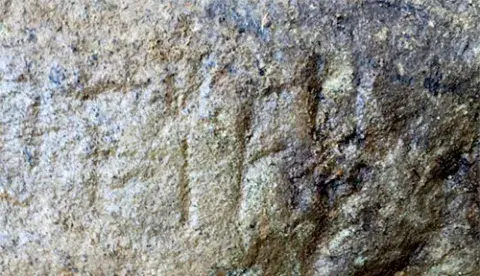

A team of archaeologists and students led by Franklin University Switzerland President and Professor of Archaeology Greg Warden recently made several exciting discoveries on Etruscan civilization in an archaeological excavation in Italy.
Key among these is a large 6th Century BC sandstone slab bearing a long inscription, what is probably a rare sacred text in the Etruscan language that is likely to yield rich details about Etruscan civilization.
The slab, or stele, was unearthed by FUS student Samuel Miller, a History major, who participated along with students from many US institutions in a Franklin field project where students are immersed in the practical and theoretical aspects of field archaeology at the Etruscan site at Poggio Colla (Vicchio di Mugello), 22 miles north of Florence, Italy.
As noted by Professor Warden, the importance of such a discovery for the university and its students is that it highlights the fundamental role played by research and teaching, together, at the university. “This particular discovery is only one example of what goes on generally at FUS: careful attention to students and the curation of opportunities that involve our students in research and provide them with experiential opportunities outside the classroom. This, after all, was the fundamental premise of our unique academic travel program, the recognition that undergraduate students can participate and contribute to a university’s research agenda inside and outside the classroom on a global scale.”
“The slab, embedded in the foundations of a monumental temple and buried underground for more than 2,500 years, at one time would have been displayed as an imposing and monumental symbol of authority,” said Professor Warden, co-director and Principal Investigator of the Mugello Valley Archaeological Project, which made the discovery. “The stele probably carries a sacred text, and will be remarkable for telling us about the early belief system of a lost culture that is fundamental to western traditions and we hope to make inroads into the Etruscan language,” Warden noted.
Scholars in the field predict the stele will yield a wealth of new knowledge about the lost culture of the Etruscans. The Etruscan civilization once ruled Rome, and influenced Romans on everything from religion to government, art and architecture.
“Inscriptions of more than a few words, on permanent materials, are rare for the Etruscans, who tended to use perishable media like linen cloth books or wax tablets,” said Jean MacIntosh Turfa, of the University of Pennsylvania Museum of Archaeology, Philadelphia, USA. “This stone stele is evidence of a permanent religious cult with monumental dedications, at least as early as the Late Archaic Period (ca. 525-480 BCE),” said MacIntosh Turfa.
“Etruscans were highly cultured people, but very little of their writing has been preserved, mostly just short funerary inscriptions with names and titles,” said archaeologist and expert in Etruscan civilization Ingrid Edlund-Berry, Professor Emerita at The University of Texas, Austin, USA. “Any text, especially a longer one, is an exciting addition to our knowledge,” noted Edlund-Berry.
Conservation and study of the stele is underway and will continue in the next few months at the conservation laboratories of the Tuscan Archaeological Superintendency in Florence by experts from the architecture department of the University of Florence. The text will be studied and published by a noted expert on the Etruscan language, Rex Wallace, Professor of Classics at the University of Massachusetts Amherst.
In two decades of excavation, the Mugello Valley Archaeological Project, regularly visited by Franklin students, has unearthed objects about Etruscan worship, beliefs, gifts to divinities, and discoveries related to the daily lives of elites and non-elites, including workshops, kilns, pottery and homes. A wealth of material culture documents ritual activity from the 7th to the 2nd century BCE, including gold jewelry, bronzes, and coins.
In the past two seasons, four 6th century bronze statuettes, also discovered by students working at the site, have been uncovered in the area of what was a monumental temple. The deposition of these figurines is connected to worship of a divinity and a fissure in the bedrock that was considered sacred. It has been hypothesized that the divinity was female, given the discovery of what is arguably the earliest scene of childbirth in western European art. The text of the newly-discovered stele may very well provide information about the nature of the cult.
The discovery of the stele was first disclosed at the 2016 Archaeological Institute of America annual meeting in San Francisco in January.
Collaborating institutions at Mugello Valley Archaeological Project include Southern Methodist University, Franklin and Marshall College, the University of Pennsylvania Museum of Archaeology and Anthropology, the Center for the Study of Ancient Italy at The University of Texas in Austin, and the Open University in the UK.
More information on FUS President Greg Warden.More information on the Mugello Valley Archaeological Project.

